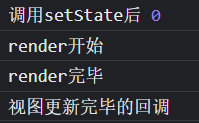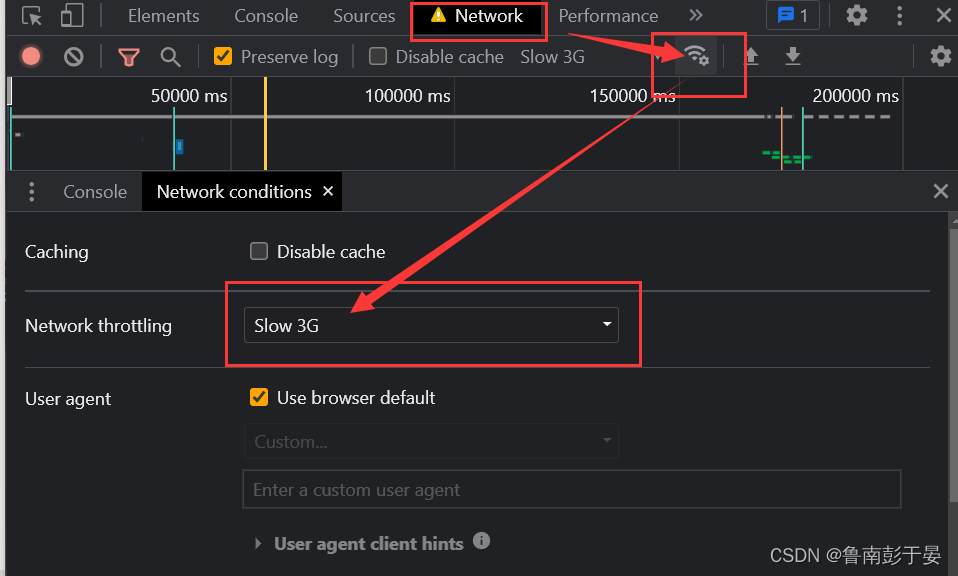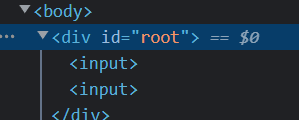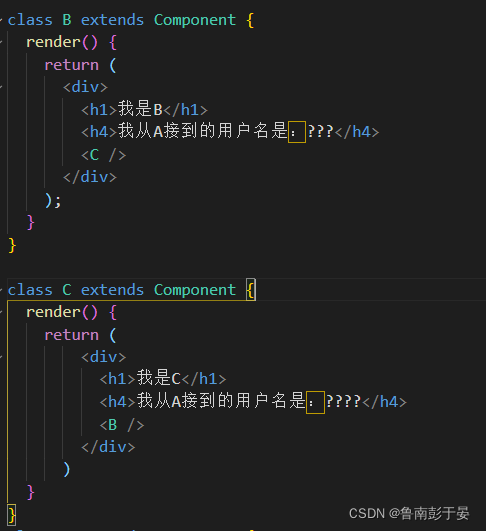跟着尚硅谷的天禹老师学习React
看视频可以直接点击 b站视频地址
下面的内容相当一部分是来自于课件内容。
1. setState
setState更新状态的2种写法
(1). setState(stateChange, [callback])------对象式的setState1.stateChange为状态改变对象(该对象可以体现出状态的更改)2.callback是可选的回调函数, 它在状态更新完毕、界面也更新后(render调用后)才被调用(2). setState(updater, [callback])------函数式的setState1.updater为返回stateChange对象的函数。2.updater可以接收到state和props。4.callback是可选的回调函数, 它在状态更新、界面也更新后(render调用后)才被调用。
总结:1.对象式的setState是函数式的setState的简写方式(语法糖)2.使用原则:(1).如果新状态不依赖于原状态 ===> 使用对象方式(2).如果新状态依赖于原状态 ===> 使用函数方式(3).如果需要在setState()执行后获取最新的状态数据, 要在第二个callback函数中读取
- setState是同步方法,但是React会异步地更新视图。
import React, {
Component } from "react";export default class Demo extends Component {
state = {
count: 0 };add = () => {
// 获取原来count值const {
count } = this.state;// 更新状态this.setState({
count: count + 1 }, function () {
console.log("视图更新完毕的回调");});console.log("调用setState后", this.state.count);};render() {
console.log("render开始");return (<div><h1>当前求和为:{
this.state.count}</h1><button onClick={
this.add}>点我+1</button>{
console.log("render完毕")}</div>);}
}

- 函数式setState的,传入的函数会接收两个值,一个是自身的state,一个是外部传入的props。
this.setState((state, props) => {
console.log(state, props); // {count: 1} {}return {
count: state.count + 1 };
});
2. lazyLoad
如果项目组件很多到影响首屏性能的话,就要使用懒加载。尤其是路由组件需要懒加载。
路由组件的lazyLoad
//1.通过React的lazy函数配合import()函数动态加载路由组件 ===> 路由组件代码会被分开打包const Login = lazy(()=>import('@/pages/Login'))//2.通过<Suspense>指定在加载得到路由打包文件前显示一个自定义loading界面<Suspense fallback={
<h1>loading.....</h1>}><Switch><Route path="/xxx" component={
Xxxx}/><Redirect to="/login"/></Switch></Suspense>
- fallback指定当懒加载的组件还没有返回时的替代组件
- fallback指定的组件,不可以再使用懒加载引入
可以使用浏览器开发者工具来测试低网速的条件下网页的呈现。

3. Hooks
函数式组件没有this,所以不能访问实例对象,Hooks解决了这个问题。
1. React Hook/Hooks是什么?
(1). Hook是React 16.8.0版本增加的新特性/新语法
(2). 可以让你在函数组件中使用 state 以及其他的 React 特性
2. 三个常用的Hook
对应了实例的三个重要属性
(1). State Hook: React.useState()
(2). Effect Hook: React.useEffect()
(3). Ref Hook: React.useRef()
3. State Hook
(1). State Hook让函数组件也可以有state状态, 并进行状态数据的读写操作
(2). 语法: const [xxx, setXxx] = React.useState(initValue)
(3). useState()说明:参数: 第一次初始化指定的值在内部作缓存返回值: 包含2个元素的数组, 第1个为内部当前状态值, 第2个为更新状态值的函数
(4). setXxx()2种写法:setXxx(newValue): 参数为非函数值, 直接指定新的状态值, 内部用其覆盖原来的状态值setXxx(value => newValue): 参数为函数, 接收原本的状态值, 返回新的状态值, 内部用其覆盖原来的状态值
Demo组件就相当于原来的render,调用次数也就是初始化一次加上后期改变状态的n次。
function Demo() {
const [count, setCount] = React.useState(0);const [name, setName] = React.useState("tom");const add = () => {
setCount((count) => count + 1);};const modifyName = () => {
setName(() => "zzy");};return (<div><h1>当前求和为:{
count}</h1><h1>我是:{
name}</h1><button onClick={
add}>点我+1</button><button onClick={
modifyName}>点我改名</button></div>);
}
4. Effect Hook
(1). Effect Hook 可以让你在函数组件中执行副作用操作(用于模拟类组件中的生命周期钩子)
(2). React中的副作用操作:发ajax请求数据获取设置订阅 / 启动定时器手动更改真实DOM
(3). 语法和说明: useEffect(() => { // 在此可以执行任何带副作用操作return () => { // 在组件卸载前执行// 在此做一些收尾工作, 比如清除定时器/取消订阅等}}, [stateValue]) // 如果指定的是[], 回调函数只会在第一次render()后执行(4). 可以把 useEffect Hook 看做如下三个函数的组合componentDidMount()componentDidUpdate()componentWillUnmount()
- useEffect的第二个参数(那个数组),可以添加对某个状态的检测。只有写了空数组才是不监测任何状态;如果不传这个参数,会监测任何状态的更新。
- useEffect可以使用多次
5. Ref Hook
(1). Ref Hook可以在函数组件中存储/查找组件内的标签或任意其它数据
(2). 语法: const refContainer = useRef()
(3). 作用:保存标签对象,功能与React.createRef()一样
6.代码
import React, {
Component } from "react";
import ReactDOM from "react-dom";function Demo() {
const [count, setCount] = React.useState(0);const add = () => {
setCount((count) => count + 1);};const unmount = () => {
ReactDOM.unmountComponentAtNode(document.getElementById("root"));};const showInputContent = () => {
const {
value } = input.current;alert(value);};const input = React.useRef();React.useEffect(() => {
const timerid = setInterval(() => {
setCount((count) => count + 1);}, 1000);return () => {
clearInterval(timerid);};}, []);return (<div><h1>当前求和为:{
count}</h1><input type="text" ref={
input} placeholder="输入内容"></input><button onClick={
add}>点我+1</button><button onClick={
unmount}>点我卸载</button><button onClick={
showInputContent}>点我展示输入框内容</button></div>);
}
export default Demo;4. Fragment
使用
<Fragment><Fragment>
<></>
区别:空标签不允许传入props,Fragment仅可以传入key(用于遍历)
作用
可以不用必须有一个真实的DOM根标签了

App.js
/* App.js */
import React, {
Component ,Fragment} from "react";
import Demo from "./components/fragment";
import {
BrowserRouter } from "react-router-dom";
export default class App extends Component {
render() {
return (<Fragment><BrowserRouter><Demo /></BrowserRouter></Fragment>);}
}
Demo.jsx
/* Demo.jsx */
import React, {
Component,Fragment } from 'react'
export default class index extends Component {
render() {
return (<><input></input><input></input></>)}
}5. Context
理解
一种组件间通信方式, 常用于【祖组件】与【后代组件】间通信
使用
1) 创建Context容器对象:const XxxContext = React.createContext() 2) 渲染子组时,外面包裹xxxContext.Provider, 通过value属性给后代组件传递数据:<xxxContext.Provider value={
数据}>子组件</xxxContext.Provider>3) 后代组件读取数据://第一种方式:仅适用于类组件 static contextType = xxxContext // 声明接收contextthis.context // 读取context中的value数据//第二种方式: 函数组件与类组件都可以<xxxContext.Consumer>{
value => ( // value就是context中的value数据要显示的内容)}</xxxContext.Consumer>
注意
在应用开发中一般不用context, 一般都用它的封装react插件
一个错误
在跟着案例走的时候,页面加载不出来,通过任务管理器发现内存增长非常快,原因是出现了循环引用,react脚手架也没有报错…找了好一会。
代码

import React, {
Component } from "react";
import "./index.css";
const MyContext = React.createContext();
const {
Provider, Consumer } = MyContext;
export default class A extends Component {
state = {
username: "tom" };render() {
const {
username } = this.state;return (<div className="parent"><h1>我是A</h1><h4>我的用户名是:{
username}</h4>{
/** 这里可以使用解构赋值 {Provider} = MyContext */}<Provider value={
{
username, age: 18 }}><B /></Provider></div>);}
}class B extends Component {
static contextType = MyContext;render() {
const {
username, age } = this.context;return (<div className="child"><h1>我是B</h1><h4>我从A接到的用户名是:{
username}</h4><C /></div>);}
}class C extends Component {
static contextType = MyContext;render() {
const {
username, age } = this.context;return (<div className="grand"><h1>我是C</h1><h4>我从A接到的用户名是:{
username}</h4><D /></div>);}
}
/* 函数使用Consumer来获取context中的值 */
function D() {
return (<div className="grand-grand"><h1>我是C</h1><Consumer>{
(value) => {
return <h4>{
`姓名是${
value.username},年龄是${
value.age}`}</h4>;}}</Consumer></div>);
}
6. 组件优化
Component的2个问题
只要执行setState(),即使不改变状态数据, 组件也会重新render() ==> 效率低
只当前组件重新render(), 就会自动重新render子组件,纵使子组件没有用到父组件的任何数据 ==> 效率低
效率高的做法
只有当组件的state或props数据发生改变时才重新render()
原因
Component中的shouldComponentUpdate()总是返回true
解决
办法1: 重写shouldComponentUpdate()方法比较新旧state或props数据, 如果有变化才返回true, 如果没有返回false
办法2: 使用PureComponentPureComponent重写了shouldComponentUpdate(), 只有state或props数据有变化才返回true注意: 只是进行state和props数据的浅比较, 如果只是数据对象内部数据变了, 返回false 不要直接修改state数据, 而是要产生新数据
项目中一般使用PureComponent来优化
代码
import React, {
PureComponent } from "react";
import "./index.css";export default class Parent extends PureComponent {
state = {
carName: "奔驰c36", stus: ["小张", "小李", "小王"] };addStu = () => {
// 要写纯函数/* const {stus} = this.statestus.unshift('小刘')this.setState({stus}) */const {
stus } = this.state;this.setState({
stus: ["小刘", ...stus] });};changeCar = () => {
//this.setState({carName:'迈巴赫'})const obj = this.state;obj.carName = "迈巴赫";console.log(obj === this.state);this.setState(obj);};// pureComponent内部不允许使用shouldComponentUpdate钩子/* shouldComponentUpdate(nextProps,nextState){// console.log(this.props,this.state); //目前的props和state// console.log(nextProps,nextState); //接下要变化的目标props,目标statereturn !this.state.carName === nextState.carName} */render() {
console.log("Parent---render");const {
carName } = this.state;return (<div className="parent"><h3>我是Parent组件</h3>{
this.state.stus} <span>我的车名字是:{
carName}</span><br /><button onClick={
this.changeCar}>点我换车</button><button onClick={
this.addStu}>添加一个小刘</button><Child carName="奥拓" /></div>);}
}class Child extends PureComponent {
// pureComponent内部不允许使用shouldComponentUpdate钩子/* shouldComponentUpdate(nextProps,nextState){console.log(this.props,this.state); //目前的props和stateconsole.log(nextProps,nextState); //接下要变化的目标props,目标statereturn !this.props.carName === nextProps.carName} */render() {
console.log("Child---render");return (<div className="child"><h3>我是Child组件</h3><span>我接到的车是:{
this.props.carName}</span></div>);}
}7. render props
如何向组件内部动态传入带内容的结构(标签)?
Vue中: 使用slot技术, 也就是通过组件标签体传入结构 <A><B/></A>
React中:使用children props: 通过组件标签体传入结构使用render props: 通过组件标签属性传入结构,而且可以携带数据,一般用render函数属性
children props
<A><B>xxxx</B>
</A>
{this.props.children}
问题: 如果B组件需要A组件内的数据, ==> 做不到
render props
<A render={(data) => <C data={data}></C>}></A>
A组件: {this.props.render(内部state数据)}
C组件: 读取A组件传入的数据显示 {this.props.data}
import React, {
Component } from 'react'
import './index.css'export default class Parent extends Component {
render() {
return (<div className="parent"><h3>我是Parent组件</h3><A render={
(name)=><B name={
name}/>}/></div>)}
}class A extends Component {
state = {
name:'tom'}render() {
console.log(this.props);const {
name} = this.statereturn (<div className="a"><h3>我是A组件</h3>{
this.props.render(name)}</div>)}
}class B extends Component {
render() {
console.log('B--render');return (<div className="b"><h3>我是B组件,{
this.props.name}</h3></div>)}
}8. 错误边界
理解:
错误边界(Error boundary):用来捕获后代组件错误,渲染出备用页面
特点:
只能捕获后代组件生命周期产生的错误,不能捕获自己组件产生的错误和其他组件在合成事件、定时器中产生的错误。
使用方式:
getDerivedStateFromError配合componentDidCatch,只有生产环境才能使用错误边界。
// 生命周期函数,一旦后台组件报错,就会触发
static getDerivedStateFromError(error) {
console.log(error);// 在render之前触发// 返回新的statereturn {
hasError: true,};
}componentDidCatch(error, info) {
// 统计页面的错误。发送请求发送到后台去console.log(error, info);
}
代码
Parent.jsx
/* Parent.jsx */
import React, {
Component } from 'react'
import Child from './Child'export default class Parent extends Component {
state = {
hasError:'' //用于标识子组件是否产生错误}//当Parent的子组件出现报错时候,会触发getDerivedStateFromError调用,并携带错误信息static getDerivedStateFromError(error){
console.log('@@@',error);return {
hasError:error}}componentDidCatch(){
console.log('此处统计错误,反馈给服务器,用于通知编码人员进行bug的解决');}render() {
return (<div><h2>我是Parent组件</h2>{
this.state.hasError ? <h2>当前网络不稳定,稍后再试</h2> : <Child/>}</div>)}
}Child.jsx
import React, {
Component } from 'react'export default class Child extends Component {
state = {
users:[{
id:'001',name:'tom',age:18},{
id:'002',name:'jack',age:19},{
id:'003',name:'peiqi',age:20},]// users:'abc'}render() {
return (<div><h2>我是Child组件</h2>{
this.state.users.map((userObj)=>{
return <h4 key={
userObj.id}>{
userObj.name}----{
userObj.age}</h4>})}</div>)}
}
9. 组件通信方式总结
组件间的关系:
- 父子组件
- 兄弟组件(非嵌套组件)
- 祖孙组件(跨级组件)
几种通信方式:
1.props:(1).children props(2).render props2.消息订阅-发布:pubs-sub、event等等3.集中式管理:redux、dva等等4.context:生产者-消费者模式
比较好的搭配方式:
父子组件:props兄弟组件:消息订阅-发布、集中式管理祖孙组件(跨级组件):消息订阅-发布、集中式管理、context(开发用的少,封装插件用的多)